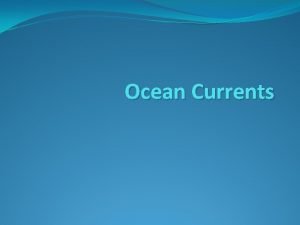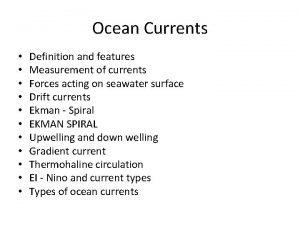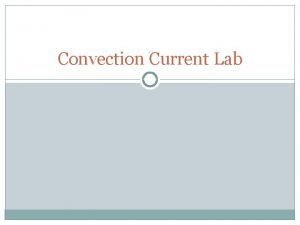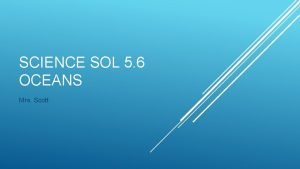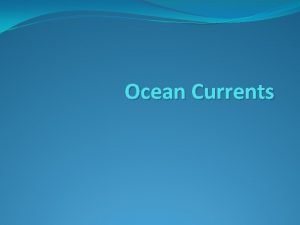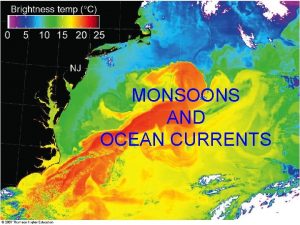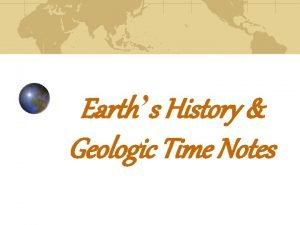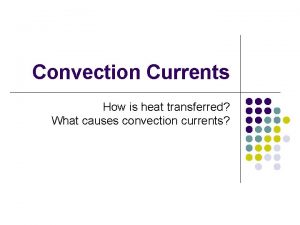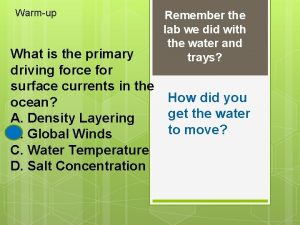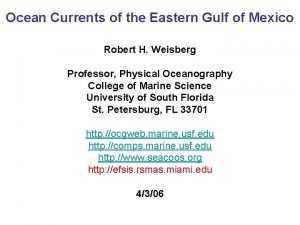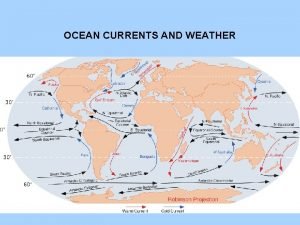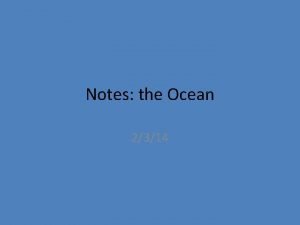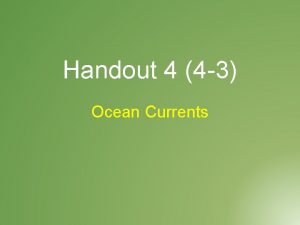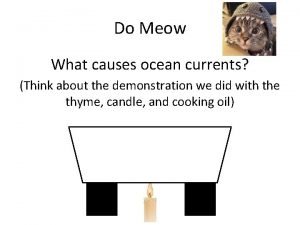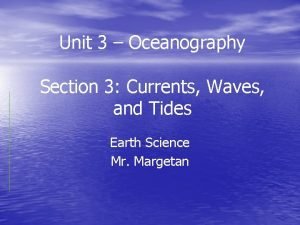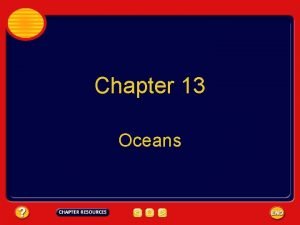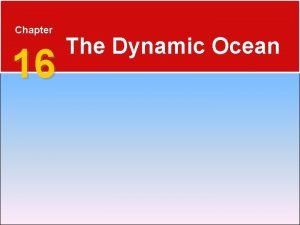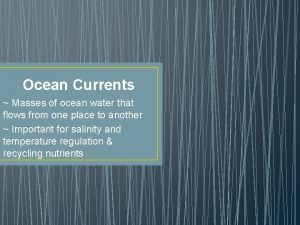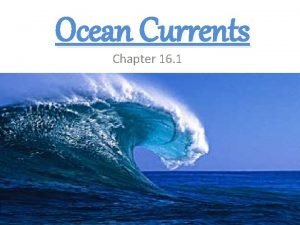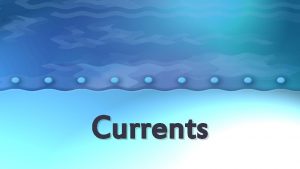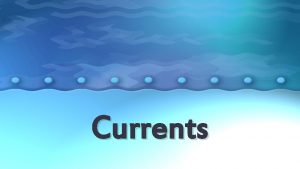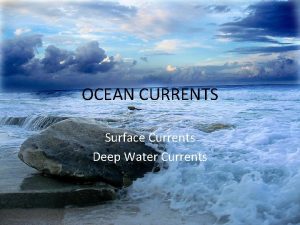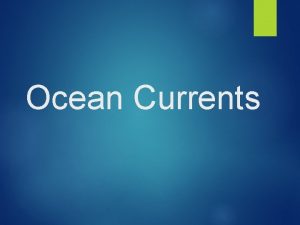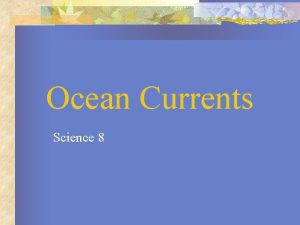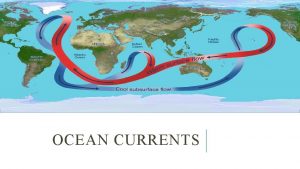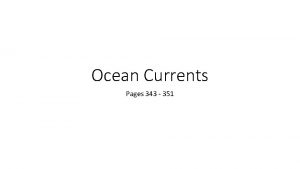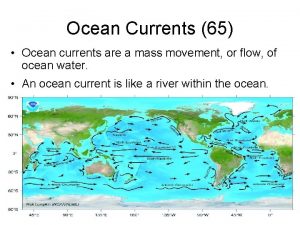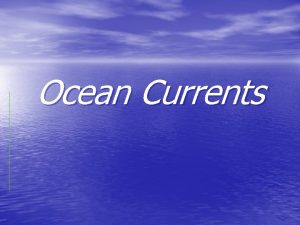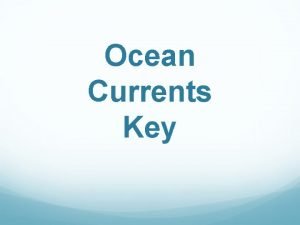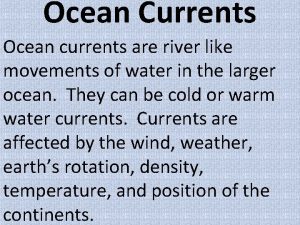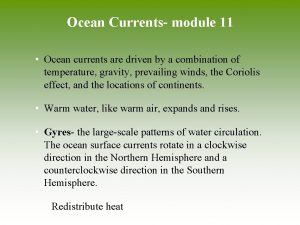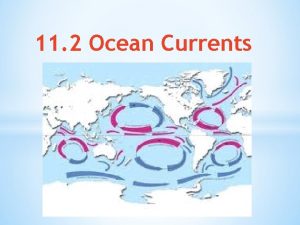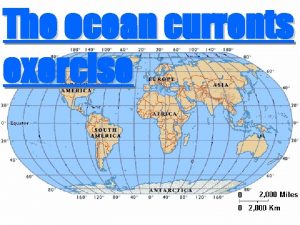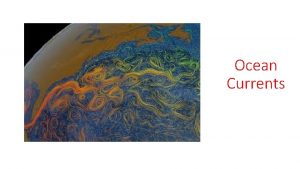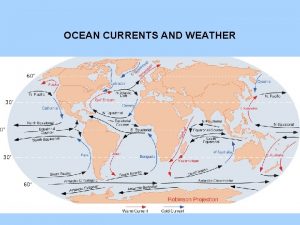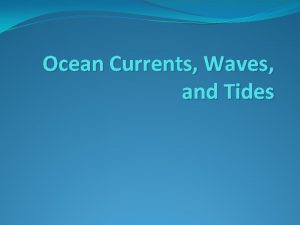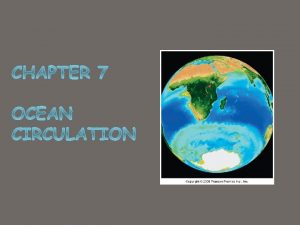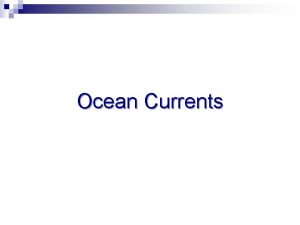Chapter 18 Ocean Currents Section One Ocean Water

























- Slides: 25

Chapter 18 Ocean Currents

Section One – Ocean Water A. Oceans are important for food, mineral, and B. energy resources: Transportation: and weather and climate. Oceans formed from volcanic water vapor. 1. Water vapor cooled, condensed into storm clouds. 2. Rain fell and filled low areas on Earth called basins.

Section One – Ocean Water… Continued C. Oceans contain gases such as oxygen, carbon dioxide, and nitrogen; the oceans also contain dissolved salts such as chloride, sodium, sulfate, magnesium, calcium, and potassium ions. 1. Salinity – measure of salts dissolved in seawater

Section One – Ocean Water… Continued 2. The elements in the ocean are balanced, which means they are added and removed at about the same rate. 3. Desalination is the process of removing salt from seawater.

Section One – Ocean Water… Section Review Questions 3. Where do the dissolved salts in the ocean water come from? 1. Rain water and ground water carry dissolved salts from the soil and rock on land into the ocean. Volcanoes also provide chlorine. 4. How does oxygen get into the oceans? 1. Some oxygen comes directly from the atmosphere and other oxygen is produced when aquatic organisms photosynthesize.

Section One – Ocean Water… Section Review Questions 1. Describe at least five ways that the Earth’s oceans affect life on our planet. o The oceans are sources of food, oxygen, minerals, medicines and energy. They play a key role in weather and climate. Oceans can be used for transportation and recreation. 2. According to scientific hypothesis, how were Earth’s oceans formed? When do scientists hypothesize they formed? o About 4 billion years ago, volcanoes released water vapor that accumulated, cooled, and condensed to fall as rain and filled tha basins.

Section One – Ocean Water… Section Review Questions 5. Organisms in the oceans are important sources of food and medicine. What steps can humans take to ensure that these resources are available for future generations? o People can conserve these resources by not over harvesting the organisms and by not polluting the oceans.

Section One – Ocean Water… Section Review Questions 6. What gases are in the ocean? o Oxygen, carbon dioxide and nitrogen are all gases found in the oceans.

Section Two – Ocean Currents A. Surface currents move the top few hundred meters of water horizontally, like rivers within the ocean. 1. The Coriolis effect is the shifting of winds and surface currents from their expected path and is caused by the Earth’s rotation. 2. Much knowledge of surface currents comes from nineteenth-century sailors.

Section Two – Ocean Currents… Continued 3. Items washed up on beaches can be used to study currents. 4. East coast surface currents are warm; west coast ocean currents are cold. B. A circulation that brings deep, cold water to the ocean surface is upwelling.

Section Two – Ocean Currents… Continued C. When a mass of seawater becomes more dense than the surrounding water, a density current forms. 1. Density currents begin in Antarctica and the North Atlantic Ocean and flow along the ocean floor towards the equator. 2. An intermediate current forms in the Mediterranean Sea.

Section Two – Ocean Currents… Section Review Questions 1. What factors create surface currents? o Winds and the Coriolis effect create surface currents. 2. What is the Coriolis effect? o The Coriolis effect is the shifting of winds and surface currents from their expected paths that is caused by the Earth’s rotation.

Section Two – Ocean Currents… Section Review Questions 3. How do Density currents circulate water? o Cold or very salty water is more dense than warm or less salty water and sinks in the ocean. This displaces warm or less salty water and makes it move upward. This drives the density currents. 4. What is upwelling? o Upwelling is a circulation in the ocean that brings deep cold water to the oceans surface.

Section Two – Ocean Currents… Section Review Questions 5. The latitude of San Diego, California, and Charleston, South Carolina, are the exact same; however, the average yearly water temperature in the ocean of Charleston is much higher than that of San Diego…explain o Atlantic ocean currents are warmer than Pacific ocean currents making the difference in water temperatures even though they have the same latitude.

Section Two – Ocean Currents… Section Review Questions 6. What are surface currents? o The top few hundred meters of water that move like rivers in the ocean are known as surface currents.

Section Three – Ocean Waves and Tides A. Waves – rhythmic movement that carries energy through matter or space 1. Waves look like hills and valleys with the crest the highest point and the trough the lowest part a. Wavelength is the horizontal distance between crests or between troughs of two adjacent waves. b. Wave height is the vertical distance between crest and trough.

Section Three – Ocean Waves and Tides… Continued 2. As a wave passes, only energy moves forward; water particles do not move 3. A breaker is a collapsing wave near the shore. a. Friction with the ocean bottom slows water at the bottom of the wave. b. Eventually, the top of the wave out runs the bottom and the wave collapses.

Section Three – Ocean Waves and Tides… Continued 4. Wind forms waves as friction piles water up; wave height depends on wind speed, distance, and time. B. The rise and fall of the sea level, called a tide, is caused by a giant wave produced by the gravitational pull of the Sun and Moon.

Section Three – Ocean Waves and Tides… Continued 1. High tide – as the crest of this giant wave approaches shore, the sea level appears to rise. 2. Low tide – later, as the trough approaches sea level appears to drop. 3. The tidal range is the difference between the ocean level at high and low tide. 4. Tidal ranges can vary; while most shorelines have tidal ranges between 1 m and 2 m, some have ranges as low as 30 cm or as high as 15 m.

Section Three – Ocean Waves and Tides… Continued 5. A wave that enters a river at rising tide is called a tidal bore. 6. Tides are caused primarily by the gravity in the Earth-Moon system 7. When the sun, Earth, and the Moon line up in certain ways, the Sun can strengthen or weaken the Moon’s effect. a. Spring tides (higher high tides and lower low tides) b. Neap tides (Lower high tides and higher lowtides)

Section Three – Ocean Waves and Tides… Section Review Questions 1. Describe the parts of an ocean wave. o o o Crest (C) – highest part Trough (T) – lowest part Wave height – vertical distance between C and T Wavelength – horizontal distance between two adjacent C or two adjacent T Amplitude – half of the wave height o Friction pulls water along with the wind. 2. How does wind create water waves?

Section Three – Ocean Waves and Tides… Continued 3. What causes high tides? Spring tides? o Tides are the result of a giant wave produced by the gravitational pull of the Sun and the Moon. That wave crest is the high tide. Spring tides are the combination of the Earth, Moon and Sun when they are in line.

Section Three – Ocean Waves and Tides… Continued 4. Compare water and wave movement? o As the wave moves horizontally through the water, particles of water are moved up, forward, down and back. 5. At the ocean, you spot a wave about 200 m from the shore. A few seconds later, the wave breaks on the beach. Explain why the water in the breaker is not the same water that was in the wave 200 m away. 1. As a wave moves it is the energy moving the particles not the actual particles moving.

Section Three – Ocean Waves and Tides… Continued 6. What factors affect wave height? o Wave height is affected by wind speed, distance, and time.

Ocean Motion Chapter Review Assignment • Page 546… Question Numbers 1 – 10 letter answers only • Page 546… Question Numbers 11 – 15 short answers • Page 547… Question Number 16 – 19 short answer/chart form/table
 Compared with surface currents deep currents are
Compared with surface currents deep currents are Chapter 15 ocean water and ocean life wordwise answer key
Chapter 15 ocean water and ocean life wordwise answer key Water and water and water water
Water and water and water water Ocean currents waves and tides
Ocean currents waves and tides Ocean currents vocabulary
Ocean currents vocabulary Surface current definition
Surface current definition Convection currents in the ocean
Convection currents in the ocean Climate types brainpop
Climate types brainpop Midnight zone
Midnight zone Ocean currents vocabulary
Ocean currents vocabulary Ocean currents
Ocean currents Cenozoic mammals
Cenozoic mammals What causes convection currents in the mantle
What causes convection currents in the mantle What is the primary driving force of surface-ocean currents
What is the primary driving force of surface-ocean currents Rubber ducks ocean currents activity
Rubber ducks ocean currents activity Ocean currents gulf of mexico
Ocean currents gulf of mexico Ocean currents and weather
Ocean currents and weather What are ocean currents
What are ocean currents Longshore currents move sediment as they _____.
Longshore currents move sediment as they _____. What are ocean currents
What are ocean currents Factors affecting climate
Factors affecting climate Ocean currents
Ocean currents Cold peruvian current
Cold peruvian current Conveyor belt
Conveyor belt Masses of ocean water that flow from one place to another
Masses of ocean water that flow from one place to another Masses of ocean water that flow from one place to another
Masses of ocean water that flow from one place to another




